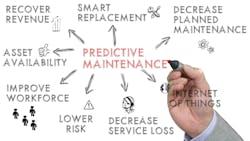Predictive maintenance: The data-driven answer to manufacturing's $50 billion problem
What you’ll learn:
- Manufacturers can now transform asset and operations management by enabling predictive maintenance.
- Reactive strategies cause costly stoppages and productivity losses.
- Preventive methods often trigger unnecessary downtime, parts replacements, and labor expenses.
Unplanned downtime ranks among the most expensive challenges in manufacturing. Industry reports estimate that unanticipated equipment and process failures cost manufacturers more than $50 billion annually.
As the sector faces volatile supply chains, escalating tariffs, and evolving production demands, one thing becomes clear: reactive maintenance models no longer suffice.
See also: AI sparks demand for specialized, high-performance plant infrastructure
Manufacturers can now transform asset and operations management by enabling predictive maintenance through data and advanced analytics.
They can harness real-time data from machinery to detect anomalies, predict failures, and proactively schedule maintenance on this equipment.
This approach reduces downtime, optimizes performance, and delivers long-term cost savings—offering a competitive edge.
Why predictive maintenance is no longer optional
Traditional maintenance strategies typically fall into two categories: reactive (fix it when it breaks) and preventive (routine servicing based on time or usage).
Amid global supply chain disruptions and rising tariffs on components and raw materials, manufacturers must extract maximum efficiency from existing equipment.
eHandbook: Predictive Maintenance
Predictive maintenance balances these extremes by utilizing machine learning, sensor data, and historical trends to assess asset health and determine the precise moment when intervention should occur. This strategic shift enables manufacturers to:
- Minimize unplanned downtime: Address potential failures before they occur.
- Optimize resource allocation: Direct maintenance teams and replacement components to assets that truly need attention.
- Extend equipment lifespan: Prevent excessive wear and tear through timely intervention.
- Reduce operational costs: Lower maintenance overhead, spare parts inventory, and production delays.
McKinsey & Co. has also found that predictive maintenance reduces overall maintenance costs by 18% to 25% while cutting unplanned downtime by up to 50%.
See also: Why preventive maintenance has become a strategic priority for manufacturers
Amid global supply chain disruptions and rising tariffs on components and raw materials, manufacturers must extract maximum efficiency from existing equipment. Predictive maintenance helps mitigate these risks by sustaining consistent uptime and performance.
Predictive maintenance and tariff mitigation
As global economic policies shift, tariffs have emerged as a significant cost factor for manufacturers, to say the least. Price increases and import taxes continue to pressure profit margins in industries ranging from steel to semiconductors.
Predictive maintenance offers indirect, yet substantial, relief. By keeping machines operating at peak performance, manufacturers reduce the need for costly replacements or upgrades. They can also minimize emergency repairs and reduce spare parts inventory, particularly useful when sourcing imported goods becomes expensive or uncertain.
Webinar replay: Building new facilities in the U.S. to avoid tariffs? Not so easy or cheap
Perhaps most importantly, predictable maintenance schedules provide flexibility, helping teams align production more effectively with changing market conditions and tariff impacts.
Predictive maintenance not only prevents downtime but also enables manufacturers to adopt leaner, more agile business models that withstand economic volatility.
The power of data access anywhere
At the core of every predictive maintenance program lies data—but not just any data—high-quality data from all aspects of the organization. Manufacturers need a flexible infrastructure that supports diverse sources, rapid processing, and scalable analytics. Equally important is the ability to access data from anywhere—whether it’s stored on-premises, in the cloud, or generated at the edge.
See also: How predictive AI can help manufacturers forecast demand for their products
Manufacturers operate in complex, distributed environments where machinery, sensors, and systems span multiple locations and platforms. To succeed, they must connect silos to ensure visibility across cloud platforms, local servers, and edge devices.
A flexible infrastructure allows teams to combine sensor insights, ERP data, and maintenance logs while scaling easily as factories grow or new sites come online. With real-time analytics and centralized data access, maintenance, operations, and IT teams collaborate seamlessly and make faster, more informed decisions.
From maintenance to optimization
Predictive maintenance delivers a clear win for manufacturers, but it marks only the beginning. The same data and infrastructure used to monitor equipment health can fuel broader optimization efforts.
A flexible infrastructure allows teams to combine sensor insights, ERP data, and maintenance logs while scaling easily as factories grow or new sites come online.
For example, manufacturers can use predictive insights to optimize production yield through real-time machine calibration. They can schedule operations more efficiently to reduce energy consumption, or link product quality data with sensor inputs to improve product quality and defect detection.
Livestream replay: Boosting legacy equipment with condition monitoring
In this way, predictive maintenance serves as a gateway to deeper industrial transformation. It shifts the focus from loss prevention to data-driven value generation. For manufacturers navigating economic uncertainty, global competition, and rising customer expectations, now is the time to adopt predictive, data-driven operations.
About the Author

Zack Izham
Zack Izham is global director of AI industry solutions at Cloudera, where he is responsible for shaping and executing complex data, analytics, and AI/ML initiatives. He brings over a decade of experience from previous roles at Carbon, Volkswagen Ag, Hewlett Packard Enterprise, Bet365 and Unilever.
